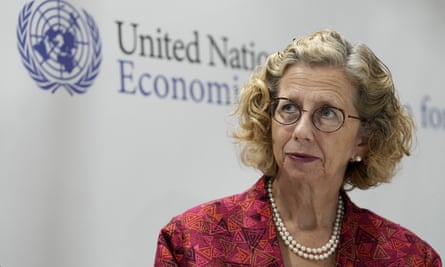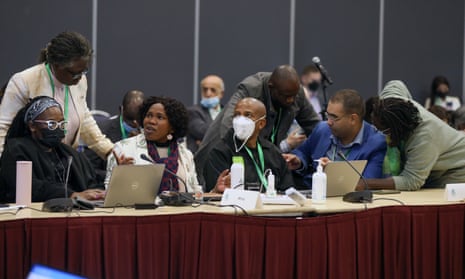The UN’s environment chief has warned that “we are at war with nature” and must “make peace”, as countries gather at Cop15 in Montreal to agree a deal to protect the planet’s biodiversity.
“We’ve just welcomed the 8 billionth member of the human race on this planet. That’s a wonderful birth of a baby, of course. But we need to understand that the more people there are, the more we put the Earth under heavy pressure,” said Inger Andersen, the executive director of the UN environment programme.
“As far as biodiversity is concerned, we are at war with nature. We need to make peace with nature. Because nature is what sustains everything on Earth … the science is unequivocal.”

Andersen emphasised that the final text of any agreement must tackle “the five horsemen of the biodiversity apocalypse”: land-use change; overexploitation; pollution; the climate crisis; and the spread of invasive species.
More than 10,000 participants are expected at Cop15, which is scheduled to run until 19 December, with ministers arriving in the second week to help finish the text. The draft targets included in the global biodiversity framework (GBF) involve proposals to protect 30% of land and sea, repurpose billions of dollars of harmful subsidies and tackle invasive species.
Q&AWhat is biodiversity and why does it matter?
Show
Biodiversity – short for biological diversity – is the variety of life on Earth, from the tiniest bacteria to the largest mammals. The air we breathe, the water we drink and the food we eat all rely on it – without plants there would be no oxygen and without bees to pollinate there would be no fruit or nuts.
Scientists are still trying to understand how the web of life fits together and, despite advances in technology, we can still only guess at the true number of species on our planet. But Earth is experiencing the largest loss of life since the dinosaurs, and humans are to blame. The way we mine, pollute, hunt, farm, build and travel is putting at least one million species at risk of extinction, say experts. The sixth mass extinction in geological history has already begun, some scientists assert, with billions of individual populations being lost.
The five biggest threats to biodiversity are: changes in land and sea use; direct exploitation of natural resources; the climate crisis; pollution and invasive species.
The extinction of animals, insects, plants, and all living things has huge knock-on effects. Species have to work together in harmony in order to thrive and provide the essential services humans need to survive. The services provided by ecosystems are estimated to be worth trillions of dollars. About half of global GDP – equal to $42tn (£37tn) – is dependent on the healthy functioning of the natural world, according to the UN.
The world has so far failed to meet any UN targets on halting the loss of nature but new targets will be set at the Cop15 biodiversity summit in Montreal in December 2022.
If governments are to reach an ambitious final agreement, China must show leadership in the talks, the EU’s environment commissioner, Virginijus Sinkevičius, told the Guardian.
China, which holds the presidency for Cop15, is the world’s biggest carbon emitter – although Canada, the US and Australia have much higher CO2 emissions per capita. It will be the first time Beijing has taken the lead on a major UN environmental agreement. Cop15 was moved from Kunming to Montreal earlier this year due to China’s zero-Covid policy, but it still presents a chance for the country to show off its “ecological civilisation” credentials to the world, a high-profile part of President Xi Jinping’s domestic agenda.
There had been fears that Beijing was trying to play down the summit, touted as a potential “Paris moment” for nature, after no world leaders were invited. China’s environment minister, Huang Runqiu, will preside over the talks in a similar role to Alok Sharma at Cop26 in Glasgow.
“I think the role of China is going to be crucial,” Sinkevičius said. “They have a lot of responsibility and as president [of Cop15], they are in a difficult position. I am happy with their engagement so far and they organised a ministerial meeting in Egypt during Cop27. We will have to see if that continues. If they want it to be a ‘Paris moment’ for nature, they have it in their hands but they have to lead.”
The biodiversity summit is key for limiting global heating to 1.5C, according to the Paris climate agreement architects, who underscored the need to live in balance with nature at last month’s climate summit. G20 leaders also emphasised its importance in their communique at the summit in Bali, Indonesia.
Governments have never met UN biodiversity targets in full and Andersen said that a proper accountability mechanism – similar to the nationally determined contributions that countries submit through the climate process – was vital if the world was to deliver on its commitments this time.
“This is our third go at [agreeing biodiversity targets]. A lot of learning has gone into understanding what happened the previous two times, and what worked and what did not,” she said. “Right now we are on this trajectory of losing 1 million of our 8 million species on this planet. That’s clearly not a trajectory we want to be on. We need to change the actions that we need to do as human beings: we need to eat and live in ways that are nature positive.”
Find more age of extinction coverage here, and follow biodiversity reporters Phoebe Weston and Patrick Greenfield on Twitter for all the latest news and features
